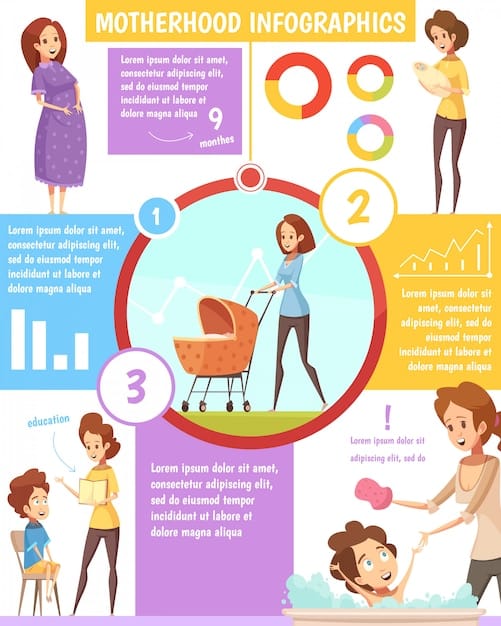The Updated Family and Medical Leave Act: Your Guide to 12 Weeks of Protected Leave in 2025

Navigating the Family and Medical Leave Act (FMLA) in 2025 can be straightforward: eligible employees are entitled to 12 weeks of unpaid, job-protected leave for qualifying family and medical reasons, ensuring job security and continued health insurance coverage during their time off.
Understanding the Updated Family and Medical Leave Act: How to Get 12 Weeks of Protected Leave in 2025 is crucial for both employees and employers. This comprehensive guide breaks down the eligibility requirements, qualifying reasons, and application process, ensuring you can confidently navigate your rights and responsibilities under the FMLA.
What is the Family and Medical Leave Act (FMLA)?
The Family and Medical Leave Act (FMLA) is a federal law designed to provide employees with job-protected, unpaid leave for specific family and medical reasons. It aims to help employees balance their work and family responsibilities.
Key Provisions of the FMLA
The FMLA entitles eligible employees of covered employers to take up to 12 workweeks of unpaid leave in a 12-month period for several reasons. These provisions ensure employees can take necessary time off without jeopardizing their employment status.
- Birth and care of a newborn child of an employee.
- Placement with the employee of a child for adoption or foster care.
- To care for an immediate family member (spouse, child, or parent) with a serious health condition.
- To take medical leave when the employee is unable to work because of a serious health condition.

Which Employers Are Covered Under FMLA?
FMLA coverage extends to both public and private sector employers who employ 50 or more employees for each working day during each of 20 or more calendar workweeks in the current or preceding calendar year. Knowing whether your employer is covered is the first step in determining your eligibility.
In summary, the FMLA is a crucial piece of legislation that supports employees during significant life events, providing a safety net that allows them to prioritize their health and family without fear of losing their jobs.
Who is Eligible for FMLA Leave in 2025?
Eligibility for FMLA leave involves specific criteria that employees must meet. These requirements ensure that the leave is used appropriately and that employers can manage their workforce effectively.
Length of Employment
To be eligible for FMLA leave, an employee must have been employed by a covered employer for at least 12 months. This requirement ensures that the employee has a significant attachment to the company before being granted leave.
Hours Worked Requirement
In addition to the length of employment, an employee must have worked at least 1,250 hours for the employer during the 12-month period immediately preceding the start of the leave. This provision ensures that the employee has been an active and engaged member of the workforce.
- The 1,250 hours include only those hours actually worked.
- Paid time off or unpaid leave do not count toward the 1,250-hour requirement.
- Employers are required to maintain accurate records of hours worked.
Geographic Proximity
Employees must also work at a location where the employer employs at least 50 employees within a 75-mile radius. This geographic requirement affects eligibility based on the size and distribution of the employer’s workforce.
In conclusion, understanding these eligibility requirements is essential for employees who are considering taking FMLA leave, as it helps them determine whether they qualify for this important benefit.
Qualifying Reasons for Taking FMLA Leave
The FMLA specifies several qualifying reasons for which an employee can take leave. These reasons are designed to cover significant life events and health conditions that require an employee’s absence from work.
Birth and Care of a Newborn Child
One of the most common reasons for taking FMLA leave is for the birth and care of a newborn child. This provision allows parents to bond with their new baby and manage the initial stages of parenthood.
Adoption or Foster Care Placement
FMLA leave also applies to employees who are welcoming a child through adoption or foster care. This ensures that adoptive and foster parents have the same rights as biological parents to take leave for bonding and care.
- Leave must be taken within 12 months of the placement.
- Both parents are eligible for leave.
- Employers may require documentation of the adoption or foster care placement.
Caring for a Family Member with a Serious Health Condition
Employees can take FMLA leave to care for an immediate family member (spouse, child, or parent) who has a serious health condition. This provision supports employees who need to provide care and support to their loved ones during times of illness.
Employee’s Own Serious Health Condition
FMLA leave also covers situations where the employee themselves has a serious health condition that makes them unable to perform the essential functions of their job. This ensures that employees can take the necessary time to recover without jeopardizing their job security.
In summary, the FMLA provides a comprehensive list of qualifying reasons that enable employees to take leave for significant life events and health conditions, ensuring that they can balance their work and personal responsibilities effectively.
How to Apply for FMLA Leave: A Step-by-Step Guide
Applying for FMLA leave involves several steps that employees must follow to ensure their request is properly processed. Understanding these steps can help streamline the application process and avoid potential complications.
Notify Your Employer
The first step in applying for FMLA leave is to notify your employer of your need for leave. This notification should be provided as soon as practicable, which means as soon as you know you need the leave.
Complete the Required Forms
Your employer will likely require you to complete certain forms to officially request FMLA leave. These forms typically include information about the reason for the leave, the expected duration, and any relevant medical information.
- Ensure all forms are filled out completely and accurately.
- Provide any supporting documentation requested by your employer.
- Keep copies of all submitted forms for your records.
Provide Medical Certification (if applicable)
In cases where the leave is due to a serious health condition, your employer may require medical certification from a healthcare provider. This certification confirms the nature and severity of the health condition and the need for leave.

Understand Your Employer’s Policies
Familiarize yourself with your employer’s specific policies regarding FMLA leave. These policies may include additional requirements or procedures that you need to follow.
In conclusion, by following these steps diligently, employees can successfully navigate the FMLA application process and secure the leave they need to address their family and medical responsibilities.
What to Expect During Your FMLA Leave
During your FMLA leave, there are certain rights and responsibilities that both employees and employers must adhere to. Understanding these aspects can help ensure a smooth and compliant leave period.
Job Protection
One of the primary benefits of FMLA leave is job protection. Upon returning from leave, employees are entitled to be restored to their original job or to an equivalent job with equivalent pay, benefits, and other terms and conditions of employment.
Maintenance of Health Insurance
During FMLA leave, employers are required to maintain the employee’s health insurance coverage under the same terms and conditions as if the employee had continued to work. This ensures that employees do not lose their health insurance coverage while on leave.
- Employees are responsible for paying their portion of the health insurance premiums.
- Employers must notify employees of their payment obligations and provide instructions for making payments.
- Failure to pay premiums can result in a loss of coverage.
Communication with Your Employer
Maintaining open communication with your employer during your FMLA leave is essential. Keep your employer informed of your status and any changes to your expected return date.
In summary, understanding what to expect during your FMLA leave can help employees manage their leave effectively and ensure that their rights are protected throughout the process.
Common FMLA Scenarios and How to Handle Them
The FMLA can be applied in various scenarios, and understanding how to handle these situations is crucial for both employees and employers. Addressing common issues proactively can help prevent misunderstandings and ensure compliance with the law.
Intermittent Leave
Intermittent leave allows employees to take FMLA leave in separate blocks of time due to a single qualifying reason. This type of leave can be useful for managing ongoing health conditions or caregiving responsibilities.
Reduced Leave Schedule
A reduced leave schedule involves reducing an employee’s usual number of working hours per workweek or workday. This can be a helpful option for employees who need to gradually return to work after a period of leave.
- Employees must provide medical certification supporting the need for intermittent or reduced leave.
- Employers can temporarily transfer employees to an alternative position that better accommodates the leave schedule.
- Both employers and employees should maintain clear records of the leave taken.
Disputes and Resolutions
In some cases, disputes may arise between employers and employees regarding FMLA leave. It is important to address these issues promptly and seek resolution through established channels.
To conclude, understanding how to handle common FMLA scenarios can help both employers and employees navigate the complexities of the law and ensure that leave is administered fairly and in compliance with FMLA regulations.
| Key Point | Brief Description |
|---|---|
| 👶 Eligibility | Must work for a covered employer for at least 12 months and 1,250 hours in the past year. |
| ⚕️ Qualifying Reasons | Includes birth, adoption, family member’s serious health condition, or your own serious health condition. |
| 📝 Application | Notify employer, complete forms, and provide medical certification if needed. |
| 🛡️ Job Protection | Guarantees return to the same or equivalent job with maintained health insurance. |
Frequently Asked Questions (FAQ)
▼
Eligible employees can take up to 12 workweeks of unpaid leave in a 12-month period for qualifying reasons, such as the birth and care of a newborn or to care for a family member with a serious health condition.
▼
FMLA leave is typically unpaid. However, some employers may offer paid leave policies that run concurrently with FMLA, or employees may use accrued paid time off (PTO) to receive income during their leave.
▼
An employer can deny your FMLA request if you are not eligible or if the reason for your leave does not qualify under the FMLA. Proper notification and documentation are essential to prevent denial.
▼
If you need more than 12 weeks of leave, you may explore options such as short-term disability, long-term disability, or additional unpaid leave, subject to your employer’s policies and applicable state laws.
▼
Intermittent leave allows you to take FMLA leave in separate blocks of time due to a single qualifying reason. You must provide medical certification supporting the need for intermittent leave, and your employer may temporarily transfer you.
Conclusion
The Family and Medical Leave Act provides essential job protection and benefits to eligible employees, ensuring they can balance their work and family responsibilities. Understanding your rights and responsibilities under the FMLA is crucial for navigating your leave effectively in 2025.





